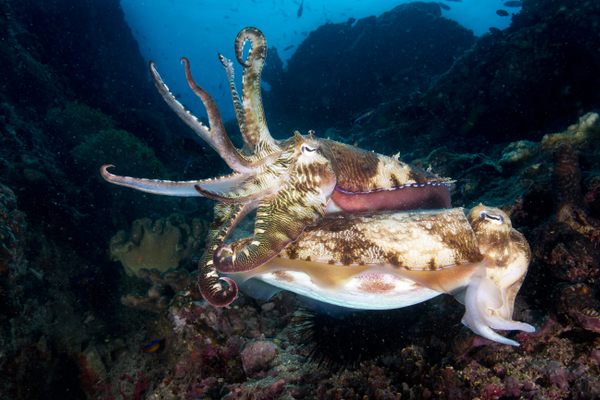Saving the Great Barrier Reef Means Saying Goodbye to a Lot of Starfish
The crown-of-thorns starfish preys upon coral, munching on its stony polyps.

The crown-of-thorns starfish has as many as 21 arms, no brain, and a thicket of quivering, venomous spines all over its body. For sustenance, it preys upon coral, munching on its stony polyps. The creature’s underside is dotted with “tube feet”, resembling enoki mushrooms. As it perambulates across the coral, these feet reach out blindly, pulling off polyps like grapes from a stem.
The feeding habits of this starfish are far more dangerous even than its thorns. When there aren’t too many of them—say, fewer than six per acre—they don’t make a significant impact on coral. But when outbreaks happen, they feed faster than the coral can grow, devastating the reef. This has been especially problematic in Australia’s iconic Great Barrier Reef where, according to the Australian Institute of Marine Science, coral cover declined by around 50 percent between 1985 and 2012. An explosion in starfish populations was responsible for almost half of that decline.
Time is up for those starfish, the Australian government says. This week, the government announced A$60 million (around $48 million) of funding to saving the reef. Of that sum, A$10 million (around $8 million) will go toward culling those starfish. In an ongoing pilot program on Swains Reef, 25 divers have been injecting starfish with bile salts. A single 10 milliliter jab will kill a starfish—over the course of nine days, each diver is aiming to kill 1,000 of them per day, for a total of nearly a quarter of a million starfish.

Researchers are unsure whether the program actually works. Indeed, some say that recent efforts appear to have made the problem worse. Other unusual uses for the money include installing giant, million-dollar fans on a small part of the reef. It’s hoped that they will cool the water down, and thus prevent coral bleaching.
Whether this cull will make a real difference remains to be seen—though either way, the lives of hundreds of thousands of starfish are on the line.













Follow us on Twitter to get the latest on the world's hidden wonders.
Like us on Facebook to get the latest on the world's hidden wonders.
Follow us on Twitter Like us on Facebook